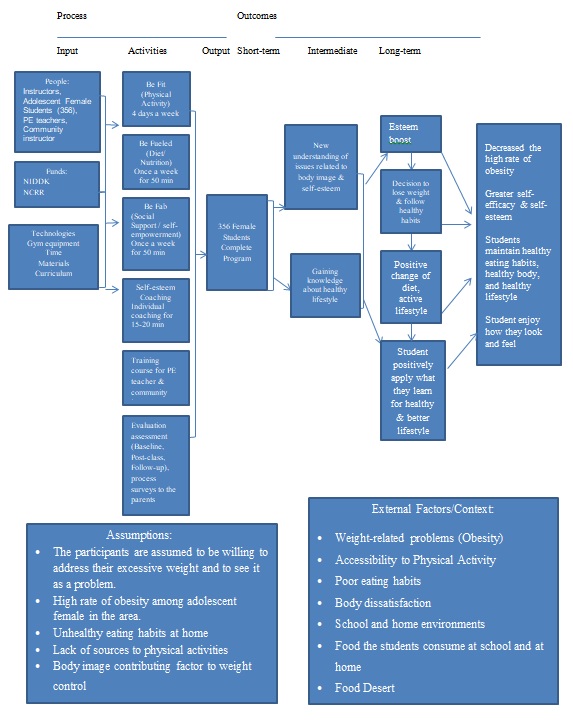Background
New Moves is a program targeting adolescent female schoolchildren who suffer from excessive weight and who are or are about to become obese. The program is designed to promote a healthy lifestyle through the development of helpful habits in the target populations. New Moves originates in the United States and is funded by the National Institute of Diabetes and Digestive and Kidney Diseases (NIDDK) and the National Center for Research Resources (NCRR). The majority of the target population is from low-income families since these individuals tend to face the problem of excessive weight more often. That is why the dietary and lifestyle alternatives offered to the target populations are to be affordable and easy to implement.
Apart from targeting healthy diet and active lifestyle changes, the program is also designed to help adolescent school girls address emotional issues caused by excessive weight (e. g. low self-esteem, social isolation, stress, anxieties, depression). New Moves has been rated as an effective intervention for obesity in teenagers (Neumark-Sztainer, et al., 2010). It is also easy to adopt and put into practice. The program is delivered in schools during physical education class over a term of nine months and is adjustable to the curriculum. New Moves program personnel also provides a structured, interactive, follow-up program to enforce and maintain behavioral changes. Students build a plan and attend to it independently with support and motivation by the tutors. The instructors’ role is to teach classes focused on diet and exercises for the target students, and also to conduct individual counseling and support sessions once or twice a week to build up the students’ self-esteem.
Stakeholder Analysis
The table below outlines the stakeholders of the program.
The intended primary users of the program are the professionals who will be able to monitor, evaluate, and (if needed) adjust the program according to the new trends or revealed tendencies. The primary users are the health care workers, program and policy developers, and the researchers who are involved in the direct design of New Moves and its implementation in the American schools. The stakeholders with the personal factor are the participants of the program (overweight school girls) and their parents. Another group of the stakeholders personally interested in the evaluation are the researchers who monitor the effectiveness of the program and care about it being done properly.
First Meeting
Preparing for the first meeting with the key stakeholders, it is important to draw out each person or group’s interest in the program and in the evaluation. The stakeholders to be invited to the meeting are the teachers, the students, their parents, and medical workers involved in health promotion and obesity prevention programs in the area. The tutors will represent the researchers. The school will invite a couple of key representatives of parents and teachers to ensure the presence of these stakeholders at the meeting. Besides, the program officials will contact the medical workers in person to invite them. The information to review will include the conclusions about the health status of the students in that school obtained from the medical staff of the school: statistics about the teenage obesity rates in the area, its causes, and broader impacts, as well as data about the effectiveness of New Moves. This data will inform the stakeholders about the structure of the program, the need for intervention in their school, and likely outcomes of the program. Next, the instructors of the program will explain its theoretical scheme and structure to the stakeholders in a simple way. A sample of the logic model of New Moves with all its aspects (targeted problems, actions, and expected results) will be demonstrated.
Further, the shareholders will be asked if they believe that the program is helpful, the reasons why it is important to implement, and the benefits of the positive outcomes. The questions do not need to be differentiated, but each of the stakeholder groups will have different answers. Besides, the stakeholders will be asked if they would like to assist the instructors with the program implementation, or if they have any comments as to the process of New Moves. The overt interests will be mentioned in the answers to the question about the benefits of New Moves. The covert interests will be inferred based on the answers. The scheme with the problems, actions and results will be filled in interactively at the meeting. The stakeholders’ answers will serve as the sources of “results” section points. Each of the stakeholder groups will have a personal interest in the program findings; yet, some will be interested professionally, and some will have a personal factor. The stakeholders who do not have any professional interest or whose life will be affected by the findings on an emotional level are those with the personal factor. The most anticipated questions will target the effectiveness of the program (the evaluation and statistics will be presented as answers).
Logic Model
Discussing the model of New Moves it is important to mention the resources such as food products for the diet promotion, information about healthy lifestyle, physical activities and equipment, space (rooms for individual sessions with the instructors, gym for group assignments), intellectual and emotional capacities (the learners and the instructors will invest personal effort to create positive outcomes).

Reference
Neumark-Sztainer D.R, Friend S.E, Flattum C.F, Hannan P.J, Story M.T, Bauer K.W, Feldman S.B, Petrich C.A. (2010). New moves-preventing weight-related problems in adolescent girls a group-randomized study. American Journal of Preventive Medicine, 39 (5), 421-432.